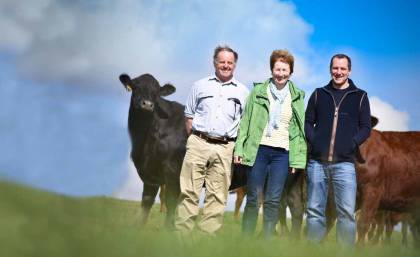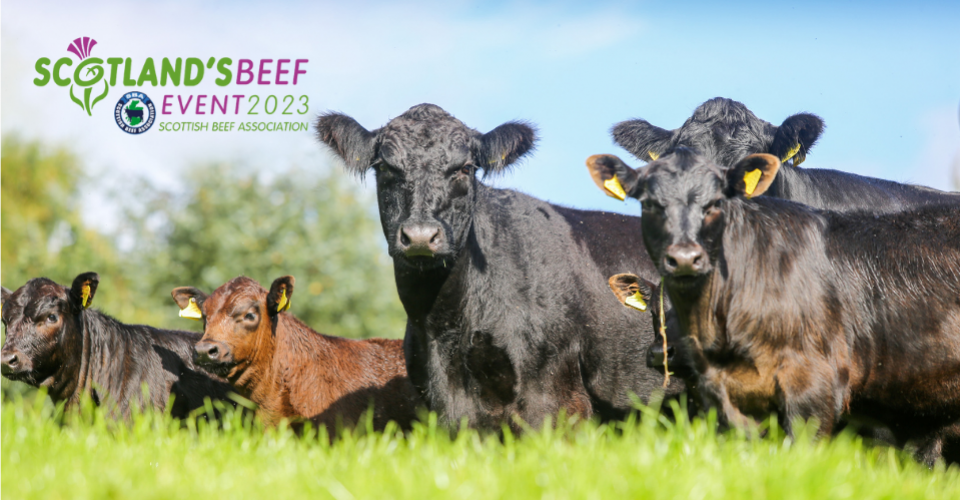Embracing Technology to Meet Market Requirements
17th May 2019
Those with an interest in beef production will have an opportunity to learn about the latest technology to help support and develop their businesses at Scotland’s Beef Event, being hosted this year by Robbie and Barbara Milne and their son James, at their North Bethelnie Farm, near Oldmeldrum in Aberdeenshire.
The Milne family run 330 Saler cows and 70 in-calf heifers on their 200-hectare grassland farm, along with a flock of 200 breeding ewes. They also rent 120 hectares of grass and 147 hectares of hill seasonally.
The Milnes are looking forward to showing visitors around their cattle enterprise on Thursday 30 May. Naturally modest, they describe their business as “very commercial and down to earth”, but it is obvious that they work very hard to produce top-quality calves, utilising technology to adapt their system constantly to satisfy the requirements of the market.
The bulls used are mainly Charolais and Salers, but more recently the Aberdeen-Angus breed has been introduced to the herd. Robbie explained that to reduce the workload the cows are split into early and late-spring calvings, with the first batch calving over a six-week period from January until mid-February and the remainder calving from April until June. Heifers are calved in November to give them time to recover before joining the January herd.
Keen to maximise their output, the Milnes have been increasing their cow numbers steadily over the last few years. As well as buying in a few heifers, they have retained the best of their Salers heifers and also some of the Angus cross Salers, which went to the bull in March. Robbie said: “We have always fancied trying out the Salers/Angus cross, which will hopefully reduce the size of our cows slightly without any loss of calf weight. Some of our cows are 800kg, which we feel is too heavy. The Angus breed is also naturally polled, which saves a lot of work.”
Ease of calving is one of the main focuses of the livestock policy at North Bethelnie, so heifers are all subject to pelvic measuring and the bottom five per cent are not retained in the herd. Heifers are bulled when they reach about 450kg and calve down at just over two years old.
Robbie and Barbara believe that it is vitally important to have a live calf on the ground, so as well as pelvic measuring females, they select bulls on ease of calving EBVs.
They import their Charolais bulls from France through an agent who knows exactly what the Milnes require in a bull.
Robbie said: “I like the fact that the French bulls are less ‘pushed’; they are very good on their feet and legs and are easy fleshed, and they also calve easily.”
Last year, fewer than nine per cent of the cows and heifers required assistance at calving and they achieved a calving percentage of 95% at weaning, although Robbie pointed out that it is not always as good as that. Barbara highlighted that the installation of cameras in the calving shed last year was a big help and added: “We can keep an eye on them from the house, so we don’t need to disturb them in the middle of the night.”
Robbie has managed to maximise his stocking density by paying careful attention to his grass. Last year he over-seeded 40 hectares with a clover mix, which has been very successful.
He manages to cut over 90 hectares of grass each year for silage in one, two or three cuts to give him plenty of fodder for his growing herd.
Cows used to be outwintered on turnips and grass until calving, but the high levels of winter rainfall in Aberdeenshire led the family to review this. They now keep the grass to make extra silage and the cows are all housed over winter on a diet of silage, straw and draff.
The knock-on effect of this is that most of the calves are now sold store instead of being taken through to finishing, as there is not enough housing. However, Robbie said: “We try to adapt our system to what the market wants, and the price has been good for store cattle over the last couple of years. We sell most of the calves at Thainstone at 10 months when they weigh 380 to 400kg.”
The January-born male calves are the exception, as they are put on an intensive barley beef ration and finished at 14 months of age.
Regardless of whether calves are sold store or finished, Robbie said: “We try to produce an animal that suits the market we decided to target with our breeding, and we are very proud of the quality and consistency of what we produce.”
Calves are all electronically tagged and weighed regularly, and the family are looking to invest in a new handling system to make recording easier. Robbie said: “The information we get from EID is great, not only for monitoring calf growth rates but also as a tool for finding the best performing cows.”
He continued: “This year we will pick out the bottom 20 per cent of cows, and if they continue to be poor performers next year then we will consider getting rid of them.”
The family has also diversified into contract grain milling. Son James runs that side of the business, and they take grain from a 50-mile radius for treatment and milling all year round, although they are at their busiest during harvest.
The Milnes believe it is vitally important to react to markets and produce what is in demand. Even in the current climate of uncertainty surrounding Brexit, the Milnes remain optimistic about the future, which is evident in the fact that they are increasing cow numbers. Robbie said: “There is likely to be some upheaval in the market place due to Brexit, and if we knew what markets we were aiming for it would be better, but I believe cattle will be in short supply in two years’ time and I want to be in a position to take advantage of that. Also, people still need to eat!”







